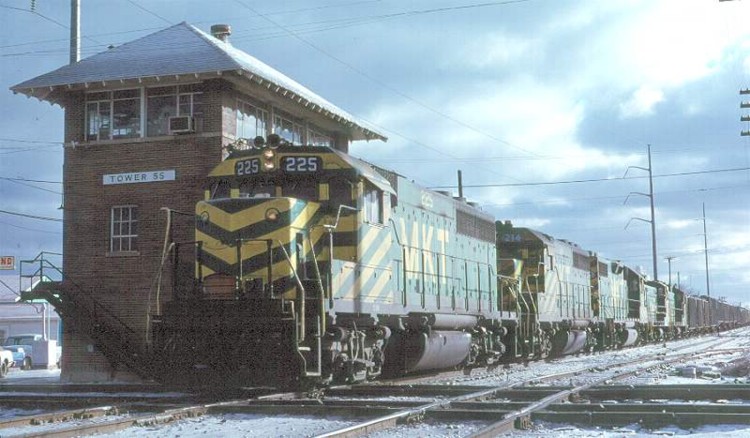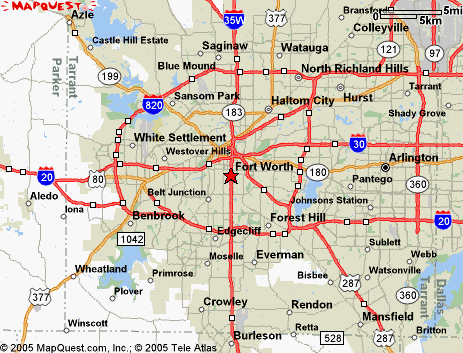Support this website by joining the Silver Rails TrainWeb Club for as little as $1 per month.
Click here for info.
This website has been archived from TrainWeb.org/mesquitebelt to TrainWeb.US/mesquitebelt.
Fort Worth, Texas

MKT 225 leads 214, another Geep and 2 switcher units Northbound through Tower 55 ; January 1rst, 1979
Photo by Bill Phillips; copyrighted by
George Elwood's photo collection available at www.rr-fallenflags.org
On June 6, 1849, Arnold established a camp on the bank of the Trinity River and named the post Camp Worth in honor of General Worth. In August 1849 Arnold moved the camp to the north-facing bluff which overlooked the mouth of the Clear Fork. The United States War Department officially named the post Fort Worth on November 14, 1849. Although Indians were still a threat in the area, pioneers were already settling near the fort. When relocating the camp, Arnold found George "Press" Farmer living on the bluff and allowed him to open the first sutler's store. Other early settlers were Ephraim M. Daggett, George W. Terrell, Ed Terrell, and Howard W. Peak.
When a new line of forts was built further west, the army evacuated Fort Worth on September 17, 1853. Settlers then took uncontested possession of the site. John Peter Smith opened a school with twelve students in 1854; Henry Daggett and Archibald Leonard started department stores. Julian Feild ran a general store and flour mill in 1856, and the Butterfield Overland Mail and the Southern Pacific Stage Line used the town as a western terminus on the way to California.
It was the developing cattle industry, however, that really began the community's economic boom. Known as Cowtown, Fort Worth offered cowboys a respite from the cattle drives to Abilene, Kansas. Northern cattle buyers established their headquarters in the town.
Transportation and communication were an important part of Fort Worth and its growth. In 1874 the first westbound stage arrived, and in 1878 the Yuma Stage Line made Fort Worth the eastern terminus to Yuma, Arizona. The Texas and Pacific Railway designated Fort Worth as the eastern terminus for the route to San Diego, California. After a delay caused by the panic of 1873 the Texas and Pacific was finally completed to Fort Worth on July 19, 1876; by 1900 the Missouri, Kansas and Texas (the "Katy"), the Santa Fe, the Fort Worth and New Orleans, the Fort Worth and Brownwood, the Fort Worth and Rio Grande, the Fort Worth and Denver City, the Fort Worth, Corsicana and Beaumont, and the St. Louis Southwestern (the "Cotton Belt") served the town.
The Fort Worth Street Railway Company ran a mile-long route down Main Street. Early newspapers were the Fort Worth Standard (1873-78), the Greenback Tribune (1878-89; later the Fort Worth Tribune), the Democrat (1876), the Democrat-Advance (1881), the Gazette (1882-98), and the Fort Worth Star-Telegram (1909-).
One of the most popular gathering places was the Texas Spring Palace, an agricultural exhibition hall built in 1889 and destroyed by fire in 1890. The palace was not only a form of entertainment but also an important part of the town's strategy for boosting commercial expansion. It was advertised throughout the nation, and special trains brought visitors from as far away as Boston and Chicago. Hell's Half Acre provided saloons and bawdy houses for cowboys and havens for desperadoes.
By the 1890s the Queen City of the Prairie, as Fort Worth liked to be known, was becoming a dressed-beef center. In North Fort Worth businessmen founded the Texas Dressed Beef and Packing Company, the Union Stockyards Company, and the Fort Worth Stockyards Company. When Swift and Company and Armour and Company began to look for Texas sites for branch plants, Fort Worth citizens pledged a bonus of $100,000 for the two companies if they would locate there. Because of this incentive, and because the town was served by railroads, Armour and Swift decided to locate a meat-packing plant in Fort Worth. The venture was successful and, combined with the stockyards, helped Fort Worth become a leading packing-house center. In 1903 the first livestock was slaughtered in the new plants. The rise of the stockyards and packing plants stimulated other livestock-related businesses.
The Fort Worth Belt Railway was a terminal line with 3.2 miles of mainline track and 15.27 miles of yard track and sidings. It was incorporated as the Fort Worth Stockyards and Belt Railway Company on November 26, 1895, and the name was changed to Fort Worth Belt on January 22, 1903. The business office was located at Fort Worth. Members of the first board of directors included George B. Robbins, J. B. Googins, O. W. Matthews, W. B. King, W. B. Robbins, W. O. Johnson, and H. C. Gardner.
The company laid thirteen miles of track in Fort Worth in 1904-05 and two miles in 1913. Although it was originally intended as a belt railway, the railroad operated as a switching line for the Fort Worth railroads and a plant facility for industries. It served several large meat, provision, grain, and produce companies in north Fort Worth, but its primary customers were the Fort Worth Stockyards Company and the Armour and Swift packing companies. In 1931, in compliance with a United States Supreme Court ruling that required all packing concerns to dispose of their interest in terminal railroads and stockyards, the Fort Worth Stockyards Company made arrangements to sell the railway.
On May 31, 1931, an agreement was signed, subject to the approval of the Interstate Commerce Commission, by which the road was acquired by the Republic National Company, which then contracted to sell 60 percent interest, valued at $900,000, to the Texas and Pacific Railway Company. Application for approval was filed on August 19, 1931, but the application was denied in March 1932, when the commission ruled that the price was too high. Sale was authorized, however, at $700,000. The Fort Worth Belt was merged into the Missouri Pacific Railroad Company on November 1, 1978.
J. B. Buchanan and C. E. Lee issued the Livestock Reporter and the North Fort Worth News. In 1896 the first Fat Stock Show was held, and in 1908 the Northside Coliseum was built to house the Southwestern Exposition and Fat Stock Show (later the Southwestern Exposition and Livestock Show). The city decided to begin the construction of new county courthouse in 1893. The leaders of Fort Worth also caught the reform spirit of the Progressive era, and in 1907 the city government was restructured to the commission form. In 1909 a devastating fire motivated the construction of a dam on the West Fork; the resulting Lake Worth provided a reliable water supply.
During World War I the United States Army established Camp Bowie which trained 100,000 men, and the United States Army Air Force converted three airfields into centers of aviation training. With the discovery of oil in Texas, refinery and pipeline companies such as Sinclair Refining Company, Texaco, and Humble Oil and Refining Company later Exxon Company, U.S.A., now MobilExxon, converged on Fort Worth, which also developed into a center for oil stock exchanges. In 1927 Meacham Field opened, offering commercial and passenger service from locally operated Braniff Airways and American Airlines.
During the Great Depression of the 1930s Fort Worth was able to secure federal money for many construction projects, including the Will Rogers Memorial Coliseum and Auditorium, as well as the renovation and building of public schools. With the outbreak of World War II the aviation industry came to Fort Worth. Consolidated Vultee Aircraft Corporation, the largest manufacturer in Fort Worth, was later bought by General Dynamics Corporation. Next to the bomber factory the Army Air Force located the Tarrant Field Air Drome, which in 1948 became Carswell Air Force Base, a part of the Strategic Air Command and a station for the B-36. Because the Trinity River had flooded severely in 1922 and 1949, Fort Worth residents secured federal money to build the Trinity River Floodway. Texas Christian University, Texas Wesleyan College, and Southwestern Baptist Theological Seminary provide higher education.
During the 1960's and 1970's Fort Worth was filled with economic activity. The Tarrant County Convention Center, the Dallas-Fort Worth International Airport, the Amon Carter Museum, and the Kimbell Art Museum were constructed. Amon Carter, Sr., publisher of the Fort Worth Star-Telegram, worked diligently to promote the city's growth. He was also a successful oil operator and owned much real estate in the area. He worked hard to publicize the city and secured government installations and projects. Over the past century the city population has boomed-6,663 in 1880, 26,668 in 1900, 277,047 in 1950, 385,164 in 1980, and 447,619 in 1990, but in spite of increasing urbanization, Fort Worth has retained its western flavor as the city "Where the West Begins."
Information from The Handbook of Texas Online; a joint project of The General Libraries at the University of Texas at Austin and the Texas State Historical Association. The Handbook of Texas Online

Map courtesy of Mapquest
Return to the Home Page
History of the towns on the Mesquite Belt
Support this website by joining the Silver Rails TrainWeb Club for as little as $1 per month.
Click here for info.














